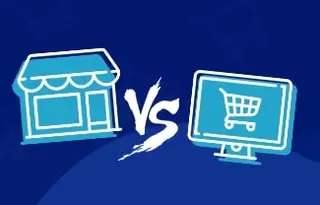Subscribe and you will promptly receive new published articles from the blog by mail
So, is it really enough to have a mere online store, where your customers buy things, whether physical or in the form of services? Why not aim higher and win the loyalty of a bigger public by really giving them a cornucopia of choices?
Perhaps you know what’s coming next – yes, that’s just how the biggest online sellers, from Snapdeal and Flipkart to Amazon went about reinventing e-commerce.
The runaway success of these buzzing forums of commerce has turned online retail on its head. Dyed-in-the-wool online sellers and startup kids alike now understand that a multi-vendor model is not just what people are asking for, but what our times demand.
E-commerce investors also understand this, preferring multi-channel business models but showing a particular liking for multi-seller marketplaces.
But what exactly allows an e-commerce store to call itself ‘multi-seller’?
Well, put simply, it’s when you extend your store so that it becomes a platform on which any number of people can sell their products – or services. More vendors means more choice and more customers flocking to the array of available price-brackets, delivery options, and so on.
Why are multi-seller e-commerce platforms receiving so much attention? Well, as any tech entrepreneur knows, innovation is the key to success – and that’s what’s allowing stores that support multiple vendors to pull away from their more traditional competitors.

After all, just look at all the advantages a multi-seller platform can offer:
- Selling an endless variety of things. Each new vendor you add to your store comes with its own range of products. This makes your store just like a thriving physical marketplace where vendors compete to give customers what they’re looking for. No surprise, then, that online stores often see sales multiplying when they go multi-seller.
- Seamless running. Managing an effective store means creating silky-smooth operations that will get the product or service to the customer as quickly as possible. But when you allow multiple vendors onboard, all this – from looking after inventories to updating catalogue listings – becomes their individual responsibility. Meanwhile, healthy competition ensures that only good service can flourish.
- Lower costs. Without the need to maintain the large teams that are demanded when you’re managing your own inventory, your overheads can be dramatically reduced. You can focus on driving your business forward and giving the best support to your customers. And dividing up the work in this way doesn’t just cut costs – it drives up quality and efficiency, too.
- Dump the inventory! The biggest headache in launching an e-commerce business is establishing the physical space to store your stock, and compiling the human resources needed to move it around. These costs can really hold your venture back, especially early on. Letting independent vendors do this work allows multi-seller platforms to focus on being great marketplaces.
- An easy path to additional income. You’ll be doing valuable work on behalf of your vendors, saving them time and resources by providing a great platform for them to sell their goods and services. In return, they’ll be more than happy to pay a commission on the sales they make on your platform – the exact amount can be adjusted according to the type of seller. The arrival of new vendors creates little additional work for you, but with each one comes another source of revenue.
- Be responsible for less, but control more. As a multi-vendor online marketplace you have the ability to pick and choose who can use your platform, and to remove unsuitable vendors at any time. Once a vendor is trading on your platform, it’s up to them to deliver the goods. This frees you from a world of daily hassle, while leaving you in total control of who trades under your ‘roof’.
Of course, none of this would work if there wasn’t an advantage for the vendor. Luckily, there are many:
- More people see their store; traffic arrives right from the get-go.
- Less can be spent on marketing, and vendors benefit from the platform’s brand.
- Far less time and money is spent than would be to set up a store from scratch.
- The vendor benefits from the knowhow and data gathered by the marketplace.
- All the technical stuff is taken care of by the management of the marketplace.
- The vendor can focus on what they do best – offering great products and services.
So, which are the services and industries best placed to benefit from multi-seller platforms?
Well, in fact, virtually every industry vertical out there can enhance its operations with multi-vendor e-commerce. Here are just some of the cases in which this business model fits:
- Selling home-cooked food; multiple chefs and home cooks can offer their dishes. The buyer thus gets to choose from a huge variety of cuisines.
- Chains of food retailers with different locations – they get the ability to give their customers a ‘local’ feel online.
- People in search of doctors and medical professionals – multi-seller platforms let the mind just the right specialist.
- Sending flowers and gifts to other parts of the globe – the gift-giver can choose a store near the recipient’s location.
- Large franchises with multiple locations can add more outlets to a single marketplace.
- Technology products, clothing, cosmetics, and almost any other e-commerce vertical can benefit from the increased choice and competition of multi-seller marketplaces.
- Community and not-for-profit organizations can increase their impact by uniting on a single platform.
With opportunities and advantages like this on offer, the only real question is: “why wait?” The world of multi-seller e-commerce has already proven its worth on a big scale, but there are doubtless still bigger successes to come – here’s to getting out there and tracking them down!
Recommended articles
 Why Cryptocurrency Payments Are the Future of Your Online Marketplace
Why Cryptocurrency Payments Are the Future of Your Online MarketplacePayment systems evolve along with new emerging human needs and wishes. The cryptocurrency boom is already changing the face of the e-commerce industry as we know it, creating many opportunities for entrepreneurs.
 Multi-Vendor Marketplace vs Online Store
Multi-Vendor Marketplace vs Online StoreHow to pick a type of an online eCommerce marketplace to lead? You either choose a multi-vendor marketplace strategy or a single-vendor analog. Find out about pitfalls of each type, how to handle them, & what is ultimately best for your business in particular in our expert article.
 An E-commerce Marketplace: A Good or a Bad Idea?
An E-commerce Marketplace: A Good or a Bad Idea?Creating e-commerce marketplaces has become something of a trend, but if we look a little closer - everything is not that simple. Read this article and make your own decision about whether it's a good idea to create an e-commerce marketplace.
 Online Payment Solutions – 5 of the Best for Your Marketplace
Online Payment Solutions – 5 of the Best for Your MarketplaceTo create an e-commerce site or online marketplace, you will have to find a safe and reliable online payment tool. Here's the list of our top 5 to facilitate your search.






